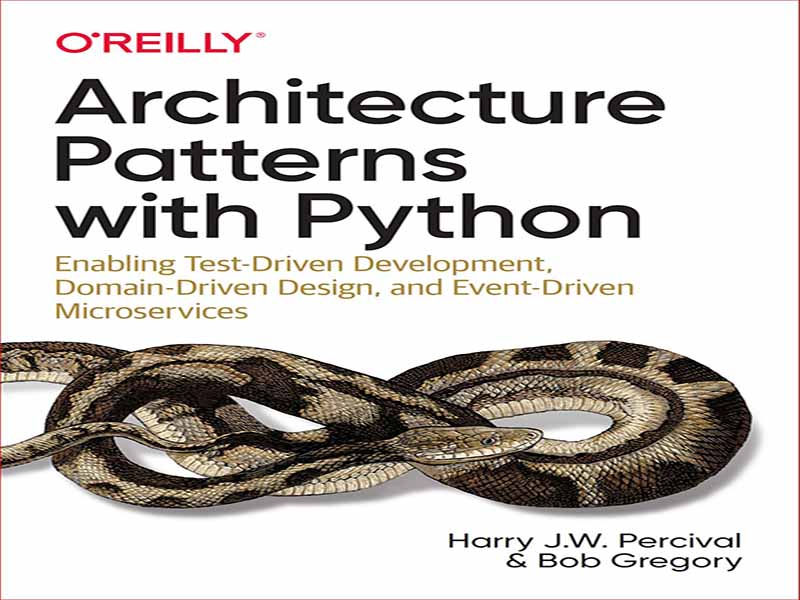- عنوان کتاب: Architecture Patterns with Python
- نویسنده: Harry Percival and Bob Gregory
- حوزه: برنامه نویسی پایتون
- سال انتشار: 2020
- تعداد صفحه: 304
- زبان اصلی: انگلیسی
- نوع فایل: pdf
- حجم فایل: 5.90 مگابایت
ممکن است تعجب کنید که ما چه کسی هستیم و چرا این کتاب را نوشتیم در پایان آخرین کتاب هری، توسعه آزمایش محور با پایتون (اوریلی)، او متوجه شد که یکسری سوالات در مورد معماری می پرسد، مثلاً چه چیزی. بهترین راه برای ساختاربندی برنامه خود به گونه ای که آزمایش آن آسان باشد، به طور خاص، به طوری که منطق اصلی کسب و کار شما توسط تست های واحد پوشش داده شود، و به طوری که تعداد تست های ادغام شده و پایان به انتها مورد نیازتان را به حداقل برسانید؟ ارجاعاتی به «معماری شش ضلعی» و «پورت ها و آداپتورها» و «هسته عملکردی، پوسته ضروری» است، اما اگر صادق بود، باید اعتراف می کرد که اینها چیزهایی نبودند که او واقعاً درک کرده بود یا در عمل انجام داده بود او به اندازه کافی خوش شانس بود که به باب برخورد کرد، کسی که پاسخ همه این سؤالات را دارد، در نهایت باب یک معمار نرم افزار بود، زیرا هیچ کس دیگری در تیمش این کار را نمی کرد، اما او به اندازه کافی خوش شانس بود با ایان کوپر مواجه شدیم که روشهای جدیدی برای نوشتن و تفکر درباره کد به او آموخت -مشکلات کسب و کار جهانی نمونه ما اولین سیستمی است که Bob برای MADE ساخته است، و این کتاب تلاشی است برای نوشتن همه چیزهایی که ما باید به برنامه نویسان جدید آموزش دهیم، زمانی که آنها به یکی از تیم های ما می پیوندند زنجیره ای از شرکای حمل و نقل و تولید کنندگان برای پایین نگه داشتن هزینه ها، ما سعی می کنیم تحویل کالا به انبارهای خود را بهینه کنیم تا کالاهای فروخته نشده در اطراف مکان نداشته باشیم درست در روزی که تصمیم به خرید آن میگیرید، و ما آن را مستقیماً به خانهتان میفرستیم بدون اینکه هرگز آن را ذخیره کنیم، زمانی که کالاها سه ماه طول میکشد تا با کشتیهای کانتینری برسند، متعادلسازی آن دشوار است. همه چیز خراب می شود یا آب آسیب می بیند، طوفان باعث تأخیرهای غیرمنتظره می شود، شرکای تدارکات به اشتباه از کالاها استفاده می کنند، کارهای اداری از بین می رود، مشتریان نظر خود را تغییر می دهند و سفارشات خود را اصلاح می کنند، و غیره ما این مشکلات را با ساختن نرم افزار هوشمندی که نشان دهنده انواع عملیات در آن است، حل می کنیم دنیای واقعی تا ما بتوانیم تا حد امکان کسب و کار را خودکار کنیم.
You may be wondering who we are and why we wrote this book. At the end of Harry’s last book, Test-Driven Development with Python (O’Reilly), he found himself asking a bunch of questions about architecture, such as, What’s the best way of structuring your application so that it’s easy to test? More specifically, so that your core business logic is covered by unit tests, and so that you minimize the number of integration and end-to-end tests you need? He made vague references to “Hexagonal Architecture” and “Ports and Adapters” and “Functional Core, Imperative Shell,” but if he was honest, he’d have to admit that these weren’t things he really understood or had done in practice. And then he was lucky enough to run into Bob, who has the answers to all these questions. Bob ended up a software architect because nobody else on his team was doing it. He turned out to be pretty bad at it, but he was lucky enough to run into Ian Cooper, who taught him new ways of writing and thinking about code. We both work for MADE.com, a European ecommerce company that sells furniture online; there, we apply the techniques in this book to build distributed systems that model real-world business problems. Our example domain is the first system Bob built for MADE, and this book is an attempt to write down all the stuff we have to teach new programmers when they join one of our teams. MADE.com operates a global supply chain of freight partners and manufacturers. To keep costs low, we try to optimize the delivery of stock to our warehouses so that we don’t have unsold goods lying around the place. Ideally, the sofa that you want to buy will arrive in port on the very day that you decide to buy it, and we’ll ship it straight to your house without ever storing it. Getting the timing right is a tricky balancing act when goods take three months to arrive by container ship. Along the way, things get broken or water damaged, storms cause unexpected delays, logistics partners mishandle goods, paperwork goes missing, customers change their minds and amend their orders, and so on. We solve those problems by building intelligent software representing the kinds of operations taking place in the real world so that we can automate as much of the business as possible.
این کتاب را میتوانید از لینک زیر بصورت رایگان دانلود کنید:
Download: Architecture Patterns with Python



































نظرات کاربران